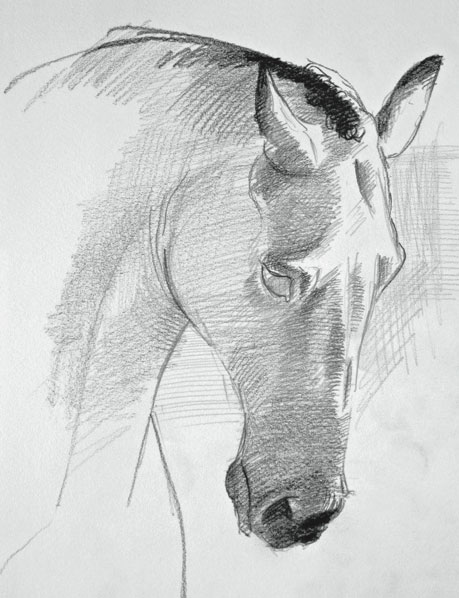Draw a Horse’s Face in 3 Steps

If you’ve ever had the pleasure of petting a horse, it’ll come as no surprise that this majestic animal is such a popular drawing subject. In the United States, they’re a common sight in city parades, racetracks, and farms. In my rural neighborhood, I can count five homesteads that have horses, and I never get tired of seeing them when I drive or walk by. That said, I have to admit that my young sons get tired of me saying, “Horse!” whenever one is out by its fence.
Equine art can be just as awe-inspiring, but if you’re chomping at the bit (yes, I said it) to draw a realistic horse, it takes practice, as well as an understanding of the bone and muscle structure that lies beneath its coarse hair. With that in mind, here’s a mini-demonstration on how to draw a horse’s head, from David Sanmiguel’s Drawing Horses: Basic Drawing and Painting Techniques.

How to Draw a Horse’s Face by David Sanmiguel
The head and neck form the most harmonious and characteristic part of the horse. The bending of the neck and its continuity along the entire face of the animal form a more or less closed curve that can at times almost be summarized as a spiral. This complex of simple shapes can be drawn with endless variations just by changing the point of view slightly. They’re all interesting and can be drawn as a diagram. The only area that may cause a problem is the muzzle, due to the complex set of curves of the nostrils and lips. To overcome these difficulties, remember that the nostrils are located more to the inside of the snout than the eyes are to the inside of the head and that the bottom lip is always behind the upper one and its volume juts out under the muzzle.

1. The bending of the head seen in profile can easily be adjusted by prolonging the curve of the neck and moving the triangle of the head towards the inside until its tip almost touches the horse’s chest.
2. We add certain details to the diagram: the angle of the volume of the cheek with the muzzle, the lower lip, the nostril, the eye and the ears.
3. With a green pencil we round out the outlines to make them look natural, we add the mane and we adjust the shape of the ears. The folds around the neck emphasize the bending of the head. ~David Sanmiguel
Now that you have this lesson, you can start sketching the face of a horse. But why stop there? For a limited time, you can get Drawing Horses with an accompanying download from Strokes of Genius 2 that features some of the best examples of horses in watermedia.
With unbridled spirit,
Cherie






Have a technical question?
Contact UsJoin the Conversation!